10 Facts About The Giant 58-Million-Year-Old Snake
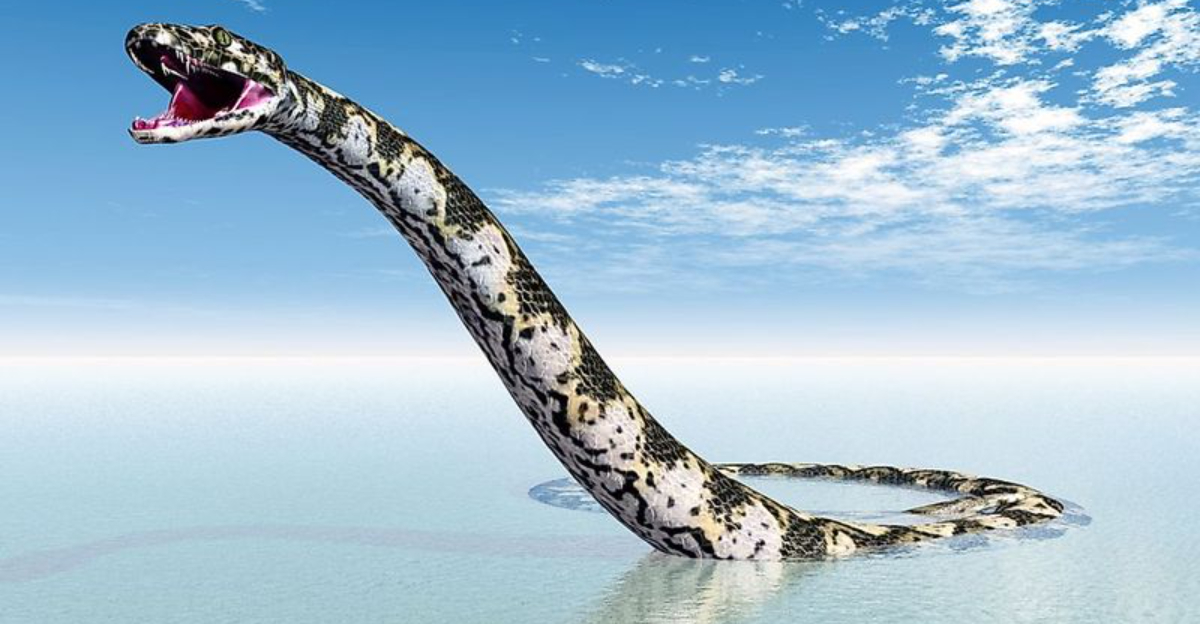
Imagine a world where a snake longer than a school bus slithers through ancient jungles. Welcome to the era of the Titanoboa, a prehistoric giant whose legacy challenges our understanding of what is possible in the animal kingdom.
With its colossal size and fascinating biology, the Titanoboa sparks the imagination and invites us into a mysterious past.
1. The Titanoboa’s Massive Size
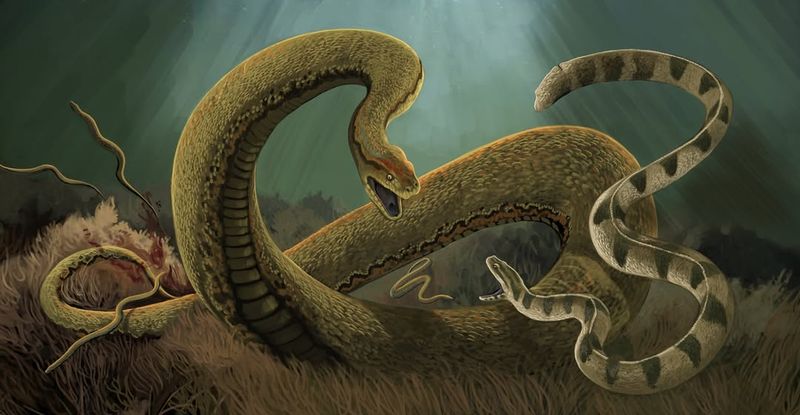
The Titanoboa was a behemoth of the snake world, stretching over 42 feet long and weighing as much as 2,500 pounds. Picture a creature so immense that it could effortlessly swallow a crocodile whole! This gargantuan size makes the Titanoboa the largest snake ever discovered, dwarfing today’s largest serpents. Fossils found in Colombia’s Cerrejón coal mines provide a glimpse into this ancient giant’s life, showcasing vertebrae larger than a human hand.
Imagine encountering such a creature in the dense, humid jungles it once roamed. It was no ordinary snake, but a true titan, blending into its environment with remarkable ease. The Titanoboa’s size was not just for show; it played a crucial role in its survival, allowing it to dominate its ecosystem.
Its immense body was a marvel of evolutionary engineering, capable of constricting its prey with bone-crushing force. The Titanoboa’s size remains a testament to the planet’s rich biological history, where creatures of unimaginable proportions once prowled the Earth. What a sight it must have been, a living relic of the past, gliding silently through primordial landscapes.
2. A Creature Of The Paleocene Epoch
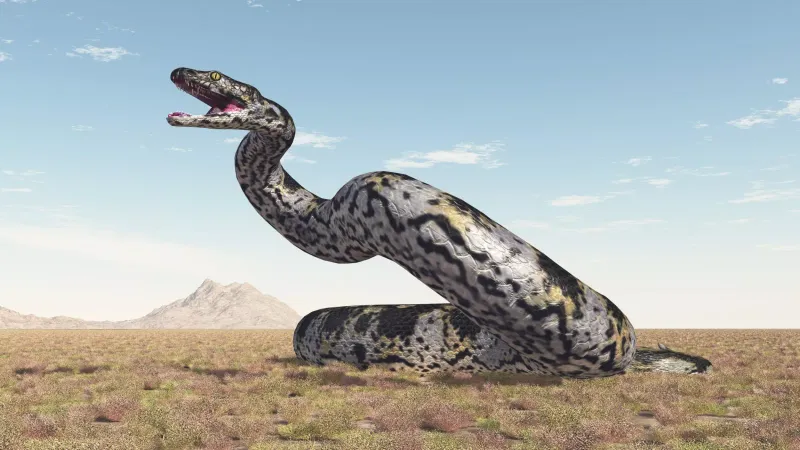
The Titanoboa thrived in the Paleocene Epoch, a period that began about 66 million years ago, right after the dinosaurs’ extinction. This era was a time of recovery and diversification for the Earth’s fauna, and the Titanoboa was its superstar. The world was warmer, with dense tropical rainforests providing the perfect backdrop for this giant predator.
With dinosaurs out of the picture, the Titanoboa took the throne as one of the top predators, slithering through the underbrush with unrivaled stealth. Imagine a world where mammals, birds, and reptiles were just beginning to reclaim dominance, and amidst them, this colossal snake reigned supreme.
The Paleocene was a cradle of evolution, where life experimented with size and form, leading to such wonders as the Titanoboa. Its existence during this epoch highlights nature’s resilience and adaptability, showcasing how life can flourish even after mass extinctions. The Titanoboa was not just a snake; it was a symbol of life’s tenacity and a reminder of the ever-changing tapestry of our planet’s history.
3. A Master Of The Waterways
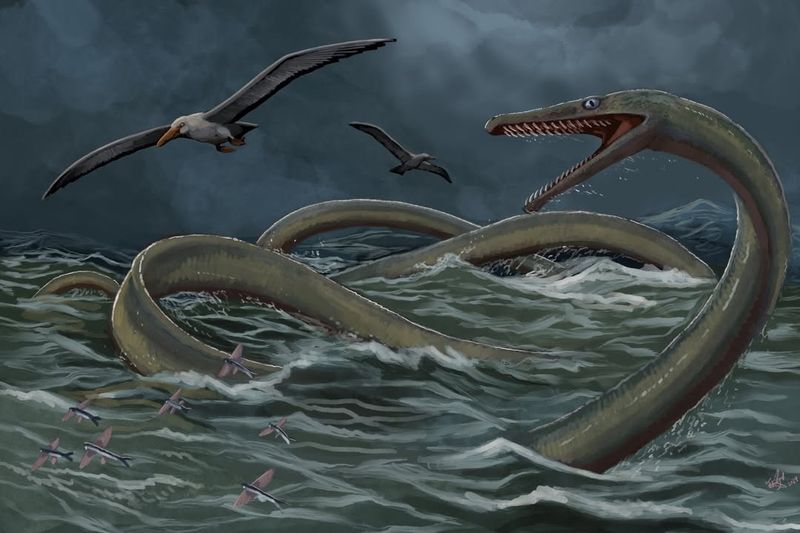
The Titanoboa was a master of aquatic environments, perfectly adapted to the waterways of its prehistoric home. Its immense body was ideal for gliding through murky rivers, where it hunted with unparalleled precision. Imagine the Titanoboa submerged, its eyes just above the waterline, waiting for unsuspecting prey to approach.
In the ancient ecosystems of South America, the Titanoboa’s aquatic prowess made it a formidable hunter. Its ability to move seamlessly between land and water allowed it to capture a wide range of prey, from fish to large reptiles. The Titanoboa’s reign over the rivers is a testament to its adaptability and dominance.
Under the water, this massive snake could disappear like a ghost, using its environment to ambush prey with deadly efficiency. The Titanoboa’s aquatic lifestyle not only highlights its predatory skills but also its role in shaping its ecosystem. As a top predator, it influenced the balance of aquatic life, reminding us of the complex interdependencies within ancient habitats.
4. Fossil Discoveries In Colombia
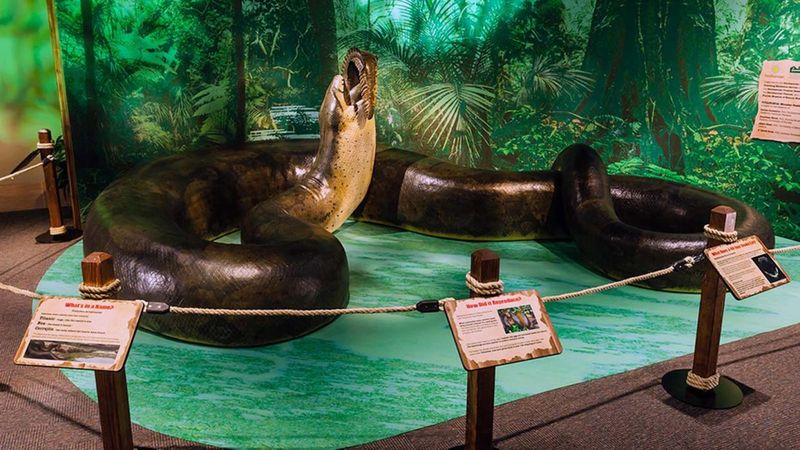
The discovery of Titanoboa fossils in Colombia’s Cerrejón coal mines was a groundbreaking moment in paleontology. These fossils, unearthed in one of the world’s largest open-pit coal mines, revealed the existence of a snake beyond imagination. Each vertebra, massive and intricate, told a story of a creature that ruled its domain millions of years ago.
The Cerrejón Formation is a treasure trove of ancient life, providing a snapshot of the Paleocene Epoch’s flora and fauna. Among the lush vegetation and ancient fauna, the Titanoboa fossils stood out, challenging our perceptions of prehistoric life. The fossils’ size and preservation offered invaluable insights into the Titanoboa’s biology and the environment it thrived in.
Unearthing these massive remains was like stepping back in time, offering a tangible connection to a world lost to history. The Titanoboa fossils not only expanded our understanding of prehistoric snakes but also underscored the importance of fossil sites like Cerrejón in piecing together Earth’s ancient past. Each fossil find is a chapter in a story that continues to fascinate and inspire.
5. The Titanoboa’s Diet
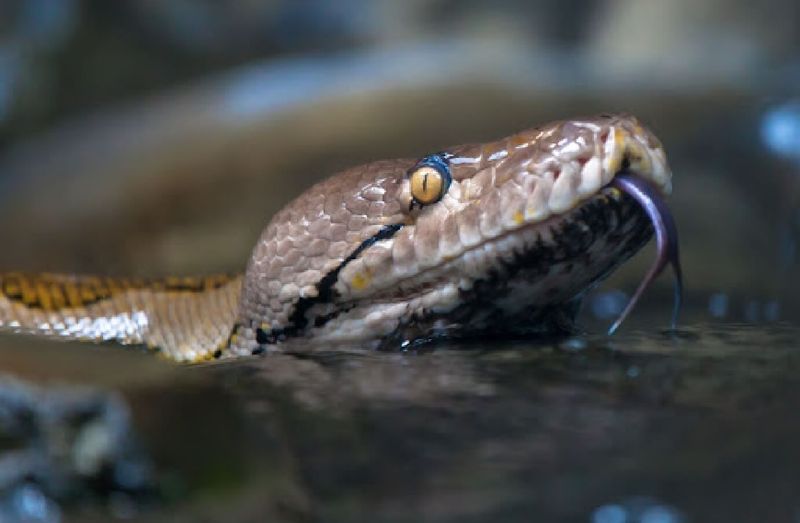
The Titanoboa was an apex predator, and its diet was as formidable as its size. Primarily feeding on large reptiles and fish, it wasn’t picky when it came to its next meal. Imagine the sheer power required to subdue a crocodile, and you’ll get a glimpse of the Titanoboa’s hunting prowess.
With constrictor capabilities that were nothing short of legendary, the Titanoboa could wrap its colossal body around prey and squeeze with bone-crushing force. This method of subduing prey showcases its incredible strength and strategy. As a master of ambush, it would often lie in wait, blending into its surroundings with eerie perfection.
The Titanoboa’s diet was a key factor in its dominance, allowing it to maintain its massive size and continue to grow. Feeding on the rich bounty of the Paleocene waters, it played a crucial role in controlling the population of other species. Its feeding habits remind us of the intricate balance within ecosystems, where each predator and prey relationship shapes the world around it.
6. A Climate Of Giants
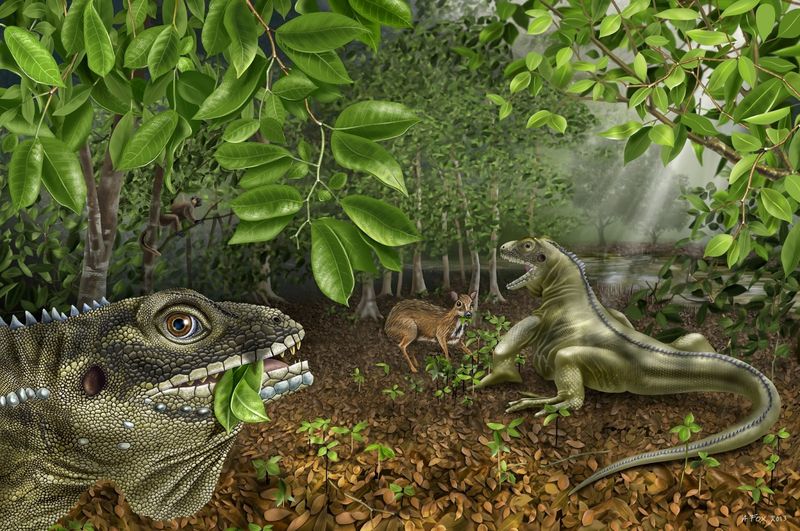
The Titanoboa inhabited a world vastly different from today, a time known as the Paleocene greenhouse. This era was characterized by high global temperatures and lush, tropical rainforests covering much of the Earth. Such a climate was perfect for the Titanoboa, allowing it to reach its gigantic proportions.
In these warm, humid jungles, the Titanoboa thrived alongside other large reptiles, contributing to a vibrant ecosystem teeming with life. The greenhouse climate fostered an explosion of biodiversity, where plants and animals adapted to the sweltering conditions. This environment was not just a backdrop but a catalyst for the Titanoboa’s evolution, providing ample resources and space for it to grow.
Understanding the climate of the Titanoboa’s time offers insights into how climate shapes evolution and biodiversity. As we face our own challenges with climate change today, the Paleocene greenhouse serves as a reminder of the dynamic nature of Earth’s climates and the profound impact they have on the living world.
7. The Titanoboa’s Skin And Coloration
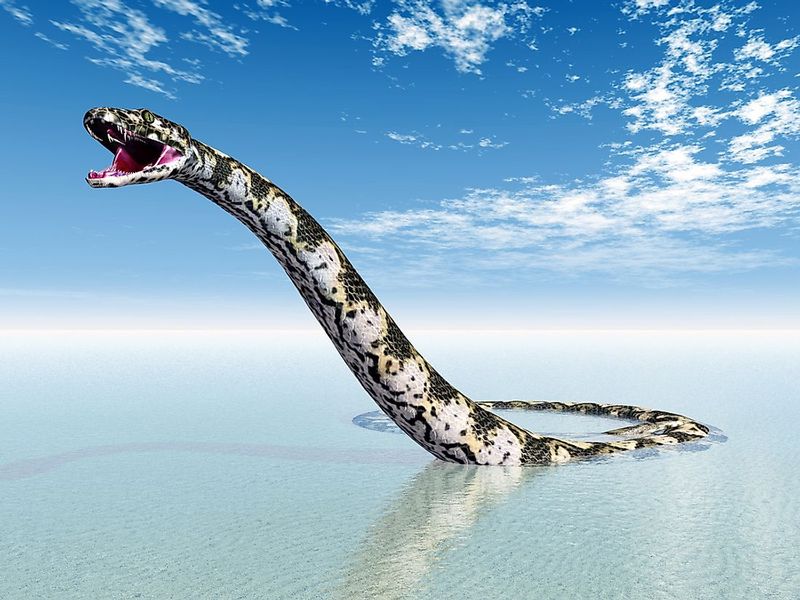
The Titanoboa’s skin was undoubtedly as impressive as its size. While no direct fossil evidence of its skin exists, scientists speculate that its coloration was likely an evolutionary masterpiece. Imagine a skin pattern so perfectly camouflaged with its jungle surroundings that this giant snake could vanish from view.
With colors and patterns designed for stealth, the Titanoboa would have been a master at blending into the lush foliage, making it an efficient ambush predator. Its skin would have been thick and resilient, capable of withstanding the rigors of both land and aquatic environments. This adaptability in its skin structure would have played a crucial role in its survival and hunting strategies.
The skin of the Titanoboa tells a story of evolution and adaptation, where every scale and color served a purpose. As we ponder the possibilities, the Titanoboa’s skin becomes a symbol of nature’s ingenuity, a reminder of how life on Earth evolves to meet the challenges of its environment in the most remarkable ways.
8. Titanoboa Vs. Modern Snakes
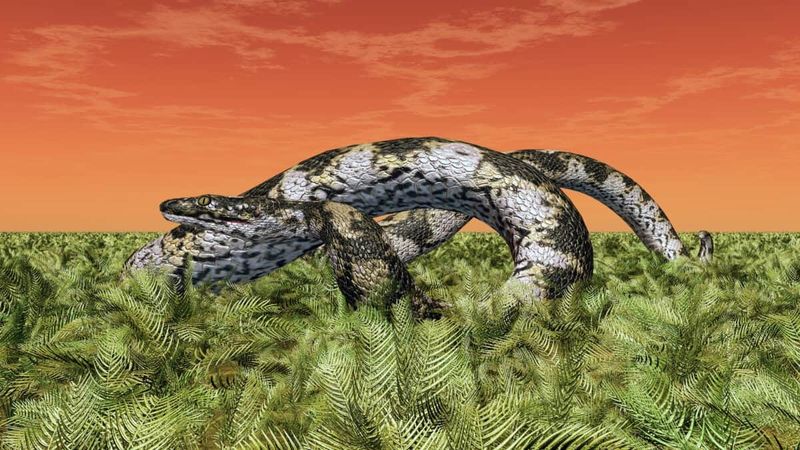
While modern anacondas and pythons are impressive in their own right, they pale in comparison to the mighty Titanoboa. Imagine placing today’s largest snake next to the Titanoboa, and you’ll see a striking difference in size and grandeur. The Titanoboa was not just larger but also exhibited behaviors and adaptations that set it apart from its modern relatives.
Its sheer size alone would have made it the undisputed ruler of its environment, unlike any snake we know today. Modern snakes like the anaconda, which can grow up to 30 feet, seem almost petite in comparison. The Titanoboa’s existence gives us a glimpse into a world where such giants were not only feasible but flourished.
Studying the Titanoboa against modern snakes helps scientists understand the evolutionary pressures and environmental conditions that shape snake biology. This comparison is more than just a size contest; it reveals the diverse paths evolution can take, reminding us of the vast potential within nature’s design.
9. The Impact Of Titanoboa On Popular Culture
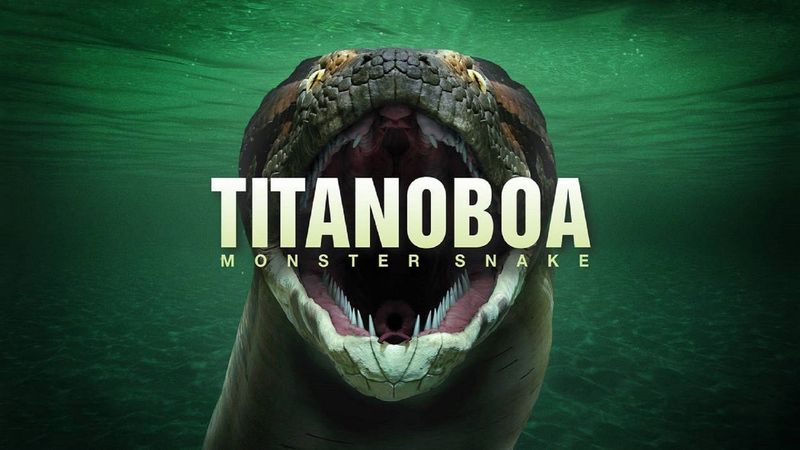
The Titanoboa’s discovery has slithered its way into popular culture, capturing imaginations and inspiring a variety of media. From documentaries to feature films, this prehistoric serpent has become a symbol of ancient mystery and power. Imagine the Titanoboa as a star in a blockbuster movie, its terrifying size bringing thrills and chills to audiences worldwide.
Its massive form and enigmatic history make it a perfect subject for storytelling, where science meets imagination. The Titanoboa has been featured in exhibitions, where life-sized replicas allow audiences to stand in awe beneath its shadow. Such displays highlight the blend of science and spectacle, bringing prehistoric life to the modern world.
Through art, film, and literature, the Titanoboa continues to fascinate, reminding us of the wonders hidden in Earth’s history. Its presence in popular culture underscores the human fascination with giants and the unknown, driving us to explore and imagine the possibilities of life beyond our current understanding.
10. Scientific Significance And Research

The Titanoboa’s discovery has been a cornerstone for scientific research, opening new avenues for understanding prehistoric life and climate. By studying its fossils, scientists gain insights into the biology of ancient snakes and the ecosystems they dominated. Imagine a team of paleontologists piecing together the puzzle of the Titanoboa’s life, each fossil a key to unlocking Earth’s distant past.
Research on the Titanoboa extends beyond its anatomy, offering clues about the Paleocene climate and how such giants could have thrived. This knowledge helps scientists predict how current and future climate changes might affect biodiversity and ecosystem dynamics. The Titanoboa serves as a window into evolutionary processes, illustrating how life adapts to environmental shifts over millennia.
The scientific exploration of the Titanoboa is a testament to human curiosity and the drive to understand our planet’s history. As researchers delve deeper into its mysteries, the Titanoboa continues to inspire and inform, bridging the gap between ancient worlds and modern science.






